人教版九年级英语Unit5写作课教学设计
- 格式:docx
- 大小:1014.83 KB
- 文档页数:4
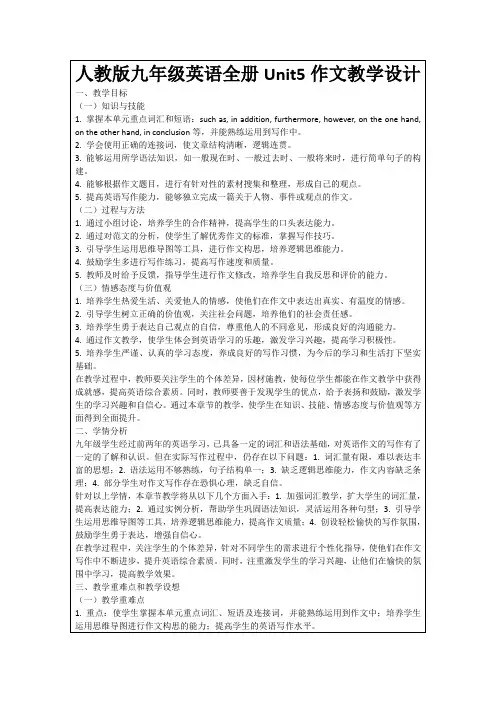
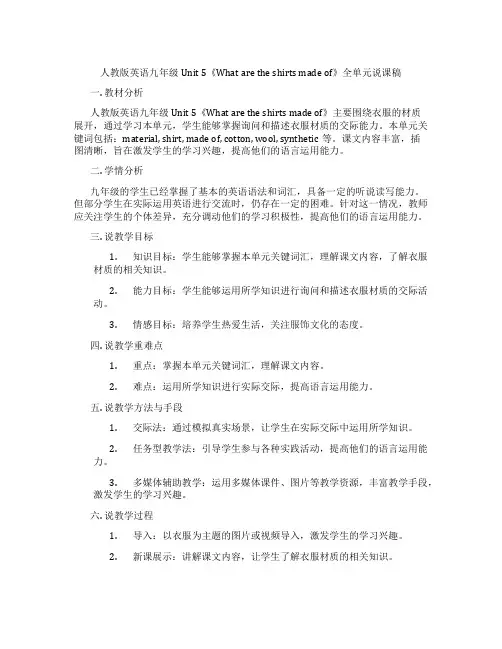
人教版英语九年级Unit 5《What are the shirts made of》全单元说课稿一. 教材分析人教版英语九年级Unit 5《What are the shirts made of》主要围绕衣服的材质展开,通过学习本单元,学生能够掌握询问和描述衣服材质的交际能力。
本单元关键词包括:material, shirt, made of, cotton, wool, synthetic等。
课文内容丰富,插图清晰,旨在激发学生的学习兴趣,提高他们的语言运用能力。
二. 学情分析九年级的学生已经掌握了基本的英语语法和词汇,具备一定的听说读写能力。
但部分学生在实际运用英语进行交流时,仍存在一定的困难。
针对这一情况,教师应关注学生的个体差异,充分调动他们的学习积极性,提高他们的语言运用能力。
三. 说教学目标1.知识目标:学生能够掌握本单元关键词汇,理解课文内容,了解衣服材质的相关知识。
2.能力目标:学生能够运用所学知识进行询问和描述衣服材质的交际活动。
3.情感目标:培养学生热爱生活,关注服饰文化的态度。
四. 说教学重难点1.重点:掌握本单元关键词汇,理解课文内容。
2.难点:运用所学知识进行实际交际,提高语言运用能力。
五. 说教学方法与手段1.交际法:通过模拟真实场景,让学生在实际交际中运用所学知识。
2.任务型教学法:引导学生参与各种实践活动,提高他们的语言运用能力。
3.多媒体辅助教学:运用多媒体课件、图片等教学资源,丰富教学手段,激发学生的学习兴趣。
六. 说教学过程1.导入:以衣服为主题的图片或视频导入,激发学生的学习兴趣。
2.新课展示:讲解课文内容,让学生了解衣服材质的相关知识。
3.实践环节:模拟真实场景,让学生进行衣服材质的询问和描述交际活动。
4.巩固环节:通过小组讨论、游戏等形式,巩固所学知识。
5.拓展环节:引导学生关注服饰文化,培养他们的审美情趣。
6.总结:对本节课内容进行总结,布置作业。
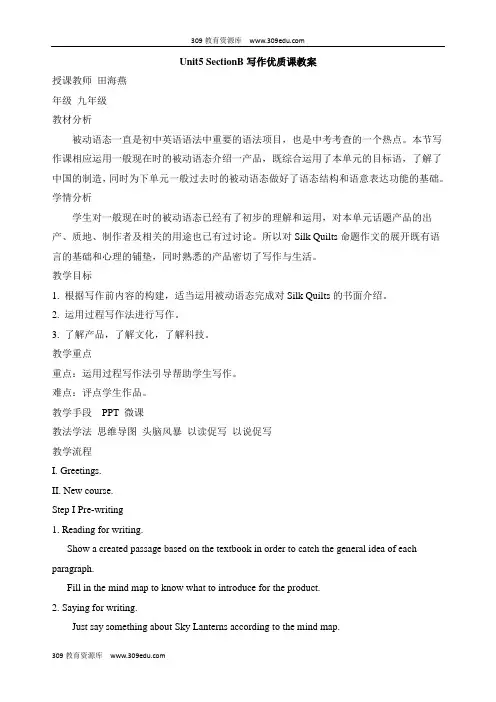
Unit5 SectionB写作优质课教案授课教师田海燕年级九年级教材分析被动语态一直是初中英语语法中重要的语法项目,也是中考考查的一个热点。
本节写作课相应运用一般现在时的被动语态介绍一产品,既综合运用了本单元的目标语,了解了中国的制造,同时为下单元一般过去时的被动语态做好了语态结构和语意表达功能的基础。
学情分析学生对一般现在时的被动语态已经有了初步的理解和运用,对本单元话题产品的出产、质地、制作者及相关的用途也已有过讨论。
所以对Silk Quilts命题作文的展开既有语言的基础和心理的铺垫,同时熟悉的产品密切了写作与生活。
教学目标1. 根据写作前内容的构建,适当运用被动语态完成对Silk Quilts的书面介绍。
2. 运用过程写作法进行写作。
3. 了解产品,了解文化,了解科技。
教学重点重点:运用过程写作法引导帮助学生写作。
难点:评点学生作品。
教学手段PPT 微课教法学法思维导图头脑风暴以读促写以说促写教学流程I. Greetings.II. New course.Step I Pre-writing1. Reading for writing.Show a created passage based on the textbook in order to catch the general idea of each paragraph.Fill in the mind map to know what to introduce for the product.2. Saying for writing.Just say something about Sky Lanterns according to the mind map.3. What to write for the product---Silk Quilts. Brainstorming questions and get the answers together.4. Show to build the writing and what expressions we use on PPT.5. Play a video for review what we learnt just now.Step II While-writingIt’s time to write for students while the teacher is moving around.Step III Post-writingChoose two students of different levels in writing and help correct some mistakes as well as learn from beautiful sentences.教学反思以读促写以说促写分别落实在了本节课中,过程写作法写前在构建写作内容时,学生头脑风暴提出的问题与我的预设有了吻合的碰撞,有一种欣喜叫“我”懂了“你”。
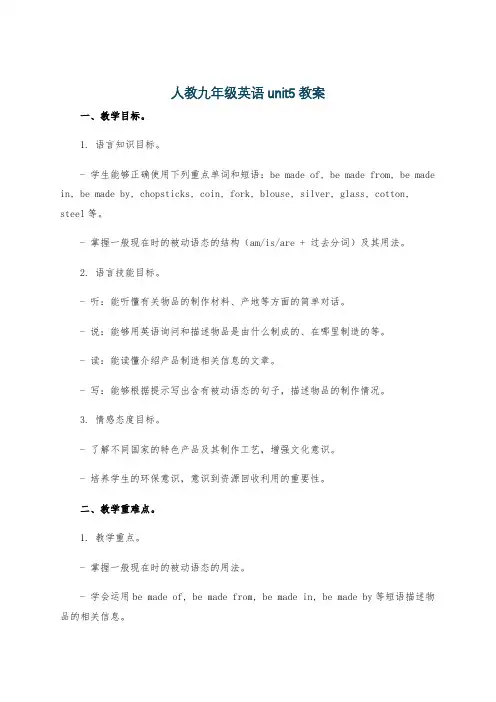
人教九年级英语unit5教案一、教学目标。
1. 语言知识目标。
- 学生能够正确使用下列重点单词和短语:be made of, be made from, be made in, be made by, chopsticks, coin, fork, blouse, silver, glass, cotton,steel等。
- 掌握一般现在时的被动语态的结构(am/is/are + 过去分词)及其用法。
2. 语言技能目标。
- 听:能听懂有关物品的制作材料、产地等方面的简单对话。
- 说:能够用英语询问和描述物品是由什么制成的、在哪里制造的等。
- 读:能读懂介绍产品制造相关信息的文章。
- 写:能够根据提示写出含有被动语态的句子,描述物品的制作情况。
3. 情感态度目标。
- 了解不同国家的特色产品及其制作工艺,增强文化意识。
- 培养学生的环保意识,意识到资源回收利用的重要性。
二、教学重难点。
1. 教学重点。
- 掌握一般现在时的被动语态的用法。
- 学会运用be made of, be made from, be made in, be made by等短语描述物品的相关信息。
2. 教学难点。
- 区分be made of和be made from的用法差异。
- 正确运用一般现在时的被动语态进行书面表达。
三、教学方法。
1. 情景教学法。
通过创设各种与物品制作相关的情景,让学生在真实的语境中学习和运用英语。
2. 任务驱动法。
布置各种任务,如小组讨论、角色扮演、调查等,让学生在完成任务的过程中提高语言综合运用能力。
3. 直观教学法。
运用图片、实物等直观教具,帮助学生更好地理解和记忆单词和短语。
四、教学过程。
(一)导入(5分钟)1. 展示一些常见物品的图片,如筷子、硬币、衬衫等,问学生:“What can you see in the pictures?”引导学生说出这些物品的英文名称。
2. 然后拿出一个用竹子做的筷子和一个用金属做的硬币,问学生:“What are they made of?”引出本节课的重点短语be made of。
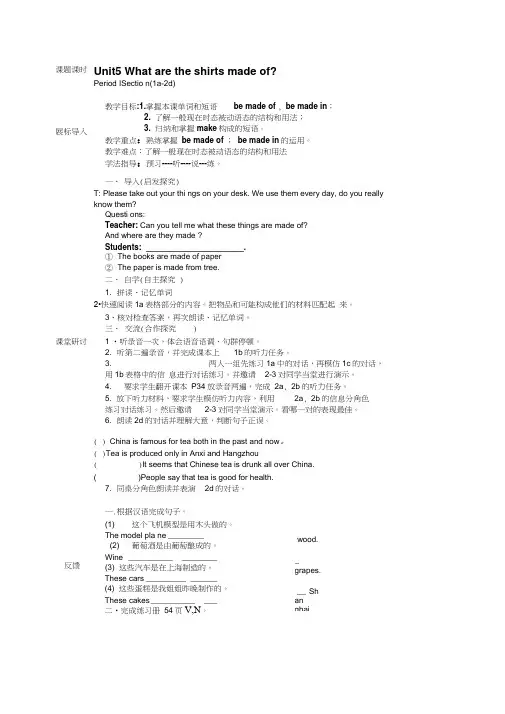
Unit5 What are the shirts made of?Period ISectio n(1a-2d)教学目标:1.掌握本课单词和短语 be made of , be made in ;2. 了解一般现在时态被动语态的结构和用法;3. 归纳和掌握make 构成的短语。
教学重点:熟练掌握 be made of ; be made in 的运用。
教学难点:了解一般现在时态被动语态的结构和用法 学法指导:预习----听----说---练。
一、 导入(启发探究) T: Please take out your thi ngs on your desk. We use them every day, do you really know them? Questi ons: Teacher: Can you tell me what these things are made of? And where are they made ? Students: ______________________ . ① The books are made of paper ② The paper is made from tree. 二、 自学(自主探究 ) 1. 拼读、记忆单词 2•快速阅读1a 表格部分的内容。
把物品和可能构成他们的材料匹配起 来。
3、核对检查答案,再次朗读、记忆单词。
三、 交流(合作探究 ) 1 •听录音一次,体会语音语调、句群停顿。
2. 听第二遍录音,并完成课本上 1b 的听力任务。
3. 两人一组先练习1a 中的对话,再模仿1c 的对话,用1b 表格中的信 息进行对话练习。
并邀请 2-3对同学当堂进行演示。
4. 要求学生翻开课本 P34放录音两遍,完成 2a , 2b 的听力任务。
5. 放下听力材料,要求学生模仿听力内容,利用 2a , 2b 的信息分角色 练习对话练习。
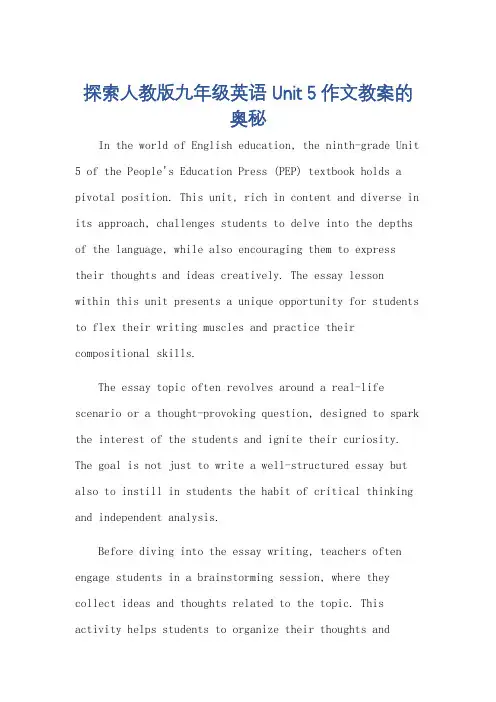
探索人教版九年级英语Unit 5作文教案的奥秘In the world of English education, the ninth-grade Unit 5 of the People's Education Press (PEP) textbook holds a pivotal position. This unit, rich in content and diverse in its approach, challenges students to delve into the depths of the language, while also encouraging them to express their thoughts and ideas creatively. The essay lessonwithin this unit presents a unique opportunity for students to flex their writing muscles and practice their compositional skills.The essay topic often revolves around a real-life scenario or a thought-provoking question, designed to spark the interest of the students and ignite their curiosity. The goal is not just to write a well-structured essay but also to instill in students the habit of critical thinking and independent analysis.Before diving into the essay writing, teachers often engage students in a brainstorming session, where they collect ideas and thoughts related to the topic. This activity helps students to organize their thoughts andidentify the main points they want to convey in their essays.The essay lesson typically begins with a carefulreading of the sample essay provided in the textbook. Teachers guide students through the essay, pointing out key features like the introduction, body paragraphs, and conclusion. They also discuss the language used, the choice of vocabulary, and the effectiveness of the sentence structure. This reading and discussion helps students to understand the basic structure and elements of a good essay. After the analysis of the sample essay, students are then given the opportunity to work on their own essays.They are encouraged to choose a topic that resonates with them and to express their opinions and ideas freely. Teachers provide guidance and feedback throughout thewriting process, helping students to shape their ideas into coherent and well-written essays.The revision and proofreading stage is also crucial. Students are taught to read their essays critically,looking for areas that need improvement. They are encouraged to revise their work, polishing the language,refining the ideas, and ensuring that their essays are free of grammatical errors and typos.The final step is the sharing and evaluation of the essays. Students are given the chance to read their essays aloud to the class, allowing their peers to provide feedback and suggestions. This sharing activity not only helps to build confidence but also encourages students to learn from each other's work.Throughout this entire process, teachers play a pivotal role. They act as guides, mentors, and critics, providing support and encouragement to students as they navigate the world of essay writing. They ensure that the students not only learn the mechanics of writing but also develop a passion for the subject and a love for the language.The essay lesson in Unit 5 of the PEP ninth-grade textbook is not just about writing an essay; it's about exploring ideas, developing critical thinking skills, and honing one's writing abilities. It's a journey that takes students deeper into the world of English, allowing them to express themselves freely and confidently.**人教版九年级英语Unit 5作文教案的深度探索**在英语教育领域中,人教版九年级英语Unit 5占据着举足轻重的地位。
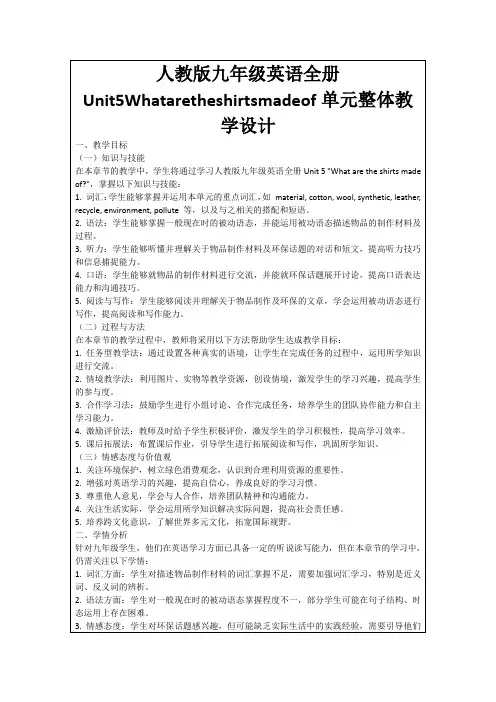
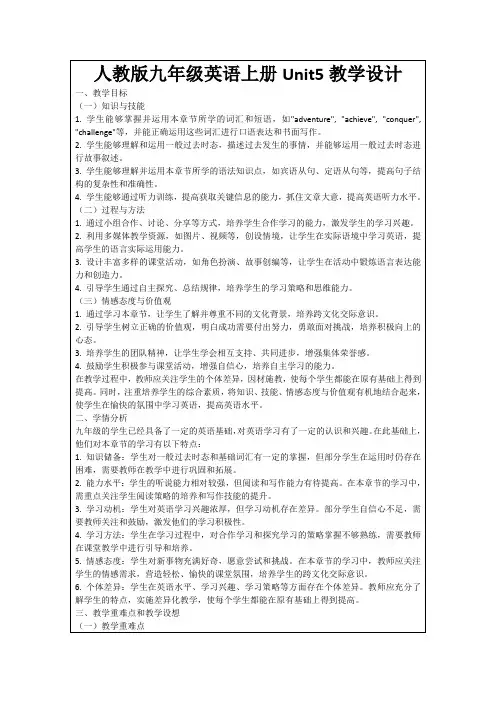
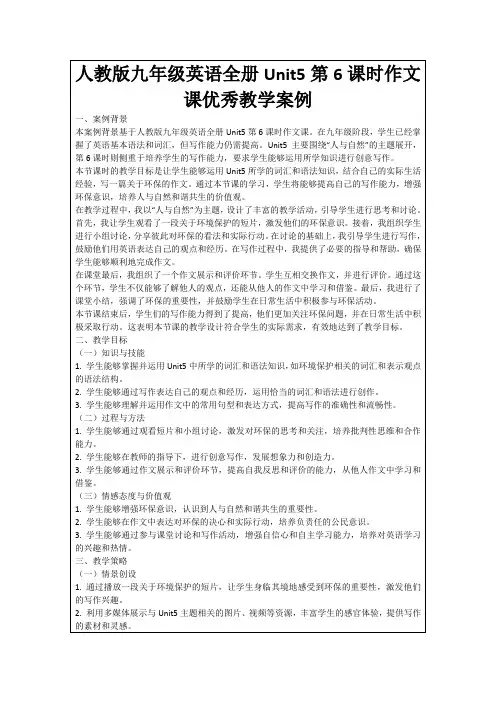
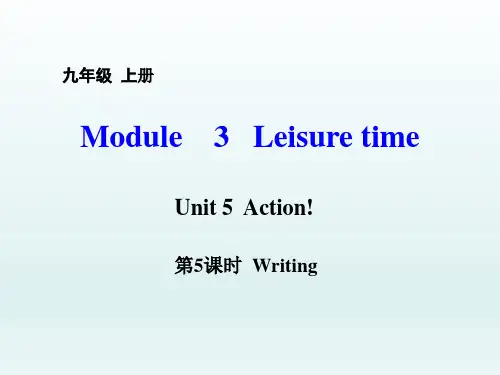

Unit5 Writing paperDear Li Hua,How excited! I’m going to your city, Hangzhou, next week. I hope I will have a wonderful time there. By the way, I want to buy something special in Hangzhou as a gift for my mother. Can you give me some advice? Looking forward to your reply.yoursMike一、写作指导1.写作内容: _________________________________________________________________________________2.时态:____________________________________________________________________________________3.谋篇布局: 第一段___________________ 第二段_________________________ 第三段_________________4.写作建议:(1)所推荐的产品要适合妈妈,并且为杭州特产;(2)从多方面具体介绍产品,如历史、原料、功能等。
二、词汇积累因...而出名________________ 一个好的选择_________________ 当地产品____________________由...制成(看得见原料)_________________ 由...制成(看不见原料)________________由sb.制成_____________________ 被用于做某事________________________保暖_____________________ 漂亮的图案____________________________三、句子积累第一段:表达欢迎,提出产品1.你下个礼拜来杭州,太好了。
Unit 5 It must belong to Carla.Ⅰ. Analysis of the Teaching MaterialStatus and FunctionThe topic of this unit is a picnic, In this unit, students learn to make inferences.Such topic is helpful to activate students’imagination and improve students’ability to deduce. Either less or more advanced students will be active in the activities in class. So it’s useful to improve students’ spoken English and communicative competence.(1) The first period mainly introduces the key vocabulary and the target language to students. Through listening and oral practice, students have a brief understanding of how to make inferences.(2)In the second period, students learn the exact meanings of the words must, might, could and can’t.Meanwhile, students practice listening and writing the target language.(3) When reading an article, students can’t help meeting with some new words. In the third period, students are asked to practise using the target language by talking about the new words, It’s helpful to arouse students’ learning interest and improve students’ listening and speaking skills. (4) The fourth period gives students further listening and oral practice using the target language by talking about an alien is chasing a man.In this class, students have a better understanding of the words must, might, could and can’t. (5) In the fifth period, students learn more vocabulary words first, and then practice reading and writing the target language. All the activities are designed to improve students’ reading and writing skills.(6)In the last period, students learn a lot of proverbs. Proverbs are full of truth and advice. Students will benefit a lot in this class.2. Teaching Aims and Demands(1) Knowledge ObjectsIn this unit, students learn to make inferences using the words must, might, could and can’t. (2) Ability ObjectsTo train students’ listening, speaking, reading and writing skills.To train students’ ability to deduce.(3) Moral ObjectsWhen you are on a picnic, remember to bring litter back to keep our environment clean and tidy. We’ll benefit a lot by learning proverbs.3. Teaching Key PointsTo learn the key vocabulary words and the target language.To learn to make inferences using the words must, might, could and can’t.4. Teaching Difficult PointsTo train students’ listening, speaking, reading and writing skills.To enable students to grasp the usage of must, might, could and can’t.5. Studying WayTeach students how to make inferences using must, might, could and can’t.Ⅱ. Language FunctionMake inferencesⅢ. Target LanguageWhose volleyball is this?It must be Carla’s. She loves volleyball.It could be Ted’s.Ⅳ. Structuremust, might, could and can’tⅤ. Vocabularypicnic, chase, escape, belong to, toy car, plate’, mystery, appointment, worried, wake, neighbor, garbageⅥ. Recyclingsuit, land, volleyball, magazine, book, CD, bat, earring, T-shirt, UFO, whose, owner, exercise, dream, anxiousⅦ. Learning Strategies1. Sequencing2. DeducingⅧ. Teaching TimeSix periodsThe First PeriodI. Teaching Aims and Demands1. Knowledge Objects(1) Key V ocabularybelong, belong to, plate, author, toy, picnic(2)Target LanguageWhose book is this?It must be Mary’s. Wanda Wilbur is her favourite author.2. Ability Objects(1) Train students’ listening skill.(2) Train students’ communicative competence using the target language.3. Moral ObjectsWhen you are on a picnic, remember to bring litter back to keep our environment clean and tidy. Ⅱ.Teaching Key Points1. Key vocabulary2. Target languageⅢ.Teaching ProceduresStep I RevisionCheck homework. Invite different students to say the answers to the exercises on pages 12~14 of the workbook.Step Ⅱ1aThis activity introduces the key vocabulary.Write the key vocabulary words on the blackboard. Say the words one by one and have students repeat several times until they can read them fluently and accurately.Ask different students to explain in their own words the meanings of the words belong to, author and picnic.Belong means to be owned by somebody.An author is a writer of a book or a play.A picnic is a meal eaten out of doors.Then invite two students to draw a plate next to the word plate and a toy car next to toy.Focus attention on the picture. Have students point to each item and say its name. Call students attention to the chart with the headlines clothing. Funthings and kitchen things at the top. Invite different students to explain the meanings of the column heads.Say, Please look at the picture and write the things you see in the correct columns in the chart. Point out the sample answers. Get students to complete the task on their own. As they work, move around the room checking their progress and answering any questions they may have.Show the correct answers on the screen by a projector.Step ⅢlbThis activity gives students practice in understanding the target langugage in spoken conversation. Call students’ attention to the chart. Set a time limit of two minutes. Students read the persons, the things and the reasons.Say, You will hear a conversation. As you listen, draw lines to connect the person in the first column with the thing in the second column. Then draw another line to connect the thing in the second line with the reason in the third column.Point out the sample answer. Say, The name Carla in the first column connects to volleyball in the second column because that’s the thing they are talking about. And the word volleyball in the second column connects with the sentence she loves volleyball in the third column.Play the recording the first time.Students only listen. Play the recording again. This time students listen and match each person with a thing and a reason.Check the answers.Step Ⅳ1cThis activity provides oral practice using the target language.Point to the picture in Activity lb. Invite pair of students to say the conversation in the speech bubbles.Point out the conversation in the box. Invite another pair of students to say it to the class. S A : Whose book is this?S B: It must be Mary’s. Wanda Wilbur is her favourite author.Write the conversation on the blackboard.Point out the chart in Activity 1b. Say.Now work with a partner. Start by reading the conversations in the picture and in the box: Then make conversations using the information in the chart in Activity 1b. Talk about who each thing might belong to and give a reason. Get students to practice in pairs. As they work, move around the classroom listening in on various pairs and offering help with language and pronunciation as needed.After all the students have had an opportunity to ask and answer questions, stop the activity. Get different pairs of students to say their conversations to the class.Step ⅤSummarySay, In this class, we’ve learned the key vocabulary words belong to, plate, author, toy and picnic and done much listening and oral practice using the target language.Step ⅥHomework(1) Say and remember the spelling of the vocabulary words.(2)Say the conversations in Activity 1c to get a further understanding of the target language.Unit 5 It must belong to Carla.The Second PeriodI. Teaching Aims and Demands1. Knowledge Objects(1) Key V ocabularydrop, symphony, optometrist, appointment, algebra, crucial, count, because of, Chinese-English dictionary, Oxford University(2) Target LanguageWhat do you think "anxious" means?Well, it can’t mean "happy".It might mean "worried".Oh, yes, she is worried because of her test.Here are some earrings. The owner can’t be a boy.Well, it could be a boy. The earrings might be a present for his mother.2. Ability Objects(1) Train students’ reading skill.(2) Train students’ communicative competence using the target language.Moral ObjectWhen you are in trouble, send an e-mail message to your friends to ask for help.Ⅱ. Teaching Key Points1.Reading practice2.Oral practice using the target languageⅢ. Teaching Difficult Points1. Key vocabulary2. Target languageⅣ. Teaching ProceduresStep I RevisionRevise the usage of the words must, might, could and can’t by checking homework.Ask students to exchange their exercises books and help correct any errors with each other, As they are doing this, move around the classroom offering language support as needed. Then invite different students to say their sentences to the class.Step Ⅱ3aThis activity provides reading practice using the target language.Call students’attention to the picture.Ask students to tell what’s happening in the picture.T: What’s the girl doing?S s: She is using the computer to write e-mail.Point to the parts of the e-mail message.Tell students that this is the message the girl in the picture writes. Say, Right now the parts are in the wrong order. When they are in the right order, they will make a clear message. Now please read the parts carefully. Number them in order. When you are doing this, you will meet with some words you don’t know.Don’t worry too much about them. Just circle them. We’ll talk about what they mean later.Get students to complete the task on their own. Point out the sample answer.Say. The first sentence of the e-mail message is I’m really anxious, because I can’t find my backpack.Check the answers.Step Ⅲ3bThis activity provides oral practice using the target language.Read the instructions to the class. Point to the sample conversation. Invite a pair of students to say it to the class.S A: What do you think "anxious" mean? S B: Well, it can’t mean "happy".S A: It might mean "worried". S B: Oh, yes. She is worried because of her test.Write the conversation on the blackboard.Say, You are to talk about the circled words in Activity 3a. Use the words can’t, must, could or might as in the sample.Get students to work with a partner. As they work in pairs, move around the classroom helping students with pronunciation and answering any questions they may have. Some time later, stop the activity. Ask different students to share their conversations with the class. Make a list of the words students are talking about on the blackboard.Practice the pronunciation of these words and explain the meaning of each word. Step ⅣPart 4This activity provides oral practice using the target language.Call students’ attention to the picture. Get students to name each item in it.Write the new words Chinese-English dictionary and Oxford University on the blackboard. Point to the sample conversation. Invite a pair of students to read it to the class.Write the conversation on the black board. Explain the meaning of each sentence. Focus attention on the chart with the headlines Can’t, Could/might and Must at the top. Point out the sample answer.Read the instructions to the class.Get students to complete the task in pairs. As the pairs work together, move around the classroom helping students with pronunciation, sentence formation or anything else they ask for help with.Ask some pairs to say their conversations to the class.Note: Answers to the chart will vary.Step ⅤSummarySay, In this class, we’ve learned some vocabulary words, such as drop, symphony.And we’ve done much oral practice using the target language.Step ⅥHomework1. Read the letter in Activity 3a again for further understanding of the vocabularywords.2. Read the conversations in Activities 3b and 4 again for further understanding of the target language.3. Finish off the exercises on pages 15~16 of the workbook.The Third PeriodI. Teaching Aims and Demands1. Knowledge Objects(1) Key Vocabulary:chase, creature(2) Target LanguageWhy do you think the man is running?He could be running for exercise.No, he’s wearing a suit. He might be running to catch a bus.2. Ability Objects(1)Train students’ listening skill.(2)Train students’ writing skill.3. Moral ObjectThe UFO and alien are both unreal. As students, we must work hard to explore the universe in the future.Ⅱ. Teaching Key Points1. Listening practice2. Writing practiceⅢ. Teaching Difficult Points1. Write a sentence about each picture.2. Write two or three sentences to finish the story.3. Listen and complete the sentences.Ⅳ. Teaching ProceduresStep ⅠRevision1. Invite a student to read the thank you message Linda wrote to Anna to the class.2. Get different pairs of students to read the conversations in Activities 3band 4.3. Check answers to the exercises on pages 15~16 of the workbook.StepⅡPart lThis activity provides writing practice using the target language.Read the instructions to the class. Read the words in the box and have students repeat several times. Invite different students to explain the meaning of each word in their own words.Get students to look at the three pictures carefully. Say, You are to use the words from the box to write a sentence about each picture. Point out where to write the sentences. Ask a student to say the sample answer to the class. Get students to complete the activity individually. As students work, walk around the classroom offering language support as needed.Check the answers on the blackboard.Step Ⅲ2aThis activity gives students practice understanding and writing the target language in spoken conversation.Read the instructions to the class. Point to the three pictures in Activity 1. Say, You will hear a conversation about these pictures. As you listen, write a number in the box in the left corner of each picture to show the order of the events.Point out the sample answer in the box of the third picture. Say, You will hear the man is running first. Play the recording the first time. Students only listen. Play the recording again. This time students listen and number the pictures. Encourage students to write two or three sentences to finish the story.Answers will vary. Write a sample version on the blackboard. Ask students to use it as a model.Step Ⅳ2bThis activity gives students practice listening to and writing the target language.Point to the chart with sentence startersThey see …The man says…and The woman says…Say, You are to listento the same recording again. And complete each sentence.Point out the sample answers. Say, They see a man running. The man says he could be running for exercise. The woman says he might be late for work. Explain the meaning of the word creature to the students.Play the recording once or twice, using the Pause button as necessary.Show the answers on the screen by a projector so thatStep Ⅴ2cThis activity provides oral practice using the target languagePoint out the sample conversation in the box. Invite a pair of students to read it to the class.S A: Why do you think the man is running?S B: He could be running for exercise.S A: No, he’s wearing a suit. He might be running to catch a bus.Write it on the blackboard.Say, Now work with a partner. Start by reading the conversation in the box with your partner. Then role play conversations using information in Activity 2b.Get students to work in pairs. As the pairs work together, walk around the classroom listening in on various pairs and offering help needed. Ask several pairs to say their conversations to the class.Step ⅥSummarySay, In this class, we’ve mainly done much listening and writing practice using the target language.Step ⅦHomeworkAsk students to collect pictures of different kinds and then talk about them using must, could, might and can’t.The Fourth PeriodI. Teaching Aims and Demands1. Knowledge Objects(1) Key Vocabularyextremely, worried, neighbor, garbage, mystery, director, escape, ocean(2) Target LanguageIn my dream, I was swimming in an ocean of paper.Maybe it means you’re afraid of too much homework!2. Ability Objects(1) Train students’ reading skill. (2) Train students’ writing skill.(3) Train students’ integrating skills.3. Moral ObjectEveryone has had a dream. But don’t dream away your time.Ⅱ. Teaching Key Points1. Key vocabulary2. Reading practice3. Writing practiceⅢ. Teaching Difficult Points1. Reading practice2. Writing practiceⅣ. Teaching ProceduresStep ⅠRevisionCheck homework.Collect pictures from students on the teacher’s desk. Hold up one at a time and ask students to describe it using the target language introduced in the preceding classes. For example:T: (Holding up a picture with a boy swimming in an ocean of books) What do you think is happening to the person in the picture?S1: He must be a student. S2: He could be having a dream. S3: He might like reading books. Step Ⅱ3aThis activity provides reading practice using the target language.Show the key vocabulary words on page 38 on the screen by a projector.Say the words one by one and have students repeat several times until they can pronounce them fluently and accurately. Read the title of the newspaper article strange events in Bell Tower neighborhood to the class. And then point to the picture and ask students. How is the person feeling? Help students to answer. He is confused and upset.Call students’ attention to the article. Read it to the class. Say, Now please read the article individually and underline what people think could be causing the strange things that are happening in Bell Tower. Point out the sample answer.Get students to complete the task individually. As they work, walk around the classroom answering any questions they may have and offering help as needed. Check the answers.Answersan animal, teenagers, the wind, a dogStep Ⅲ3bThis activity provides reading and writing practice using the target language.Get students to discuss any words or sentences they don’t know in Activity 3a with one another. Call students’attention to the three sets of notes. Ask different students to read them to the class.Chu family--late night footsteps in the hallway--might be the neighborsLao Zheng--someone trying to get in the window--might be the windXiao Ning--finds garbage in front of her house--might be catsSay, You are to write another paragraph about Bell Town using these notes. You may use the article inActivity 3a as a model. Ask students to write their paragraphs on their own in the exercise books. As they work, move around the classroom offering language support as needed. Get a few students to read their works to the class. Answers will vary. Write the sample version on the blackboard.Step Ⅳ3cThis activity provides writing practice using the target language.Read the title No more mystery in Bell Tower neighborhood to the class and explain the meaning of the word mystery. Invite a student to read the opening sentences to the class. Divide the class in to groups of four to discuss what should be included in the article.Two or three minutes later, stop the activity. Say, Now please finish the article about the strange events in Bell Tower. Use the ideas you discussed along with original ideas of your own to complete the article. Get students to complete the task on their own in the exercise books. As they are writing, move around the classroom offering help as needed. Ask some students to read their articles to the class.Collect students’ works and write a comment on each paper before returning them.Step ⅤPart 4This activity provides reading, writing, listening and speaking practice using the target language. Read the instructions to the class. Point to the picture. Ask students to tell what is happening in it. Invite a pair of students to read the sample conversation in the box to the class.Say, Once I had a dream. In my dream, I was eating a state dinner. What might the dream mean? Students may answer.Maybe it means you are too hungry. Say. Think of a dream you had recently and tell your classmates about it Your classmates guess what the dream might mean. Please work with a partner. Start practice by reading the sample conversation. As the pairs work together, walk around the room offering help with pronunciation and language. Ask different pairs to tell the class about their dream and what they may mean.Step ⅥSummarySay, In this class, we’ve mainly done much reading and writing practice using the target language. We’ve learned some vocabulary words as well.Step ⅦHomework1. Reread the newspaper article in Activity 3a.2. Review the paragraph in Activity 3b,The Fifth PeriodI. Teaching Aims and Demands1. Knowledge Objects(1)Key Vocabularyfinger, stone, ant, poor, dishonest, bark, wake, pretend, use up, attempt(2)Fill in blanks and make sentences using vocabulary words.(3)Learn some proverbs.(4)Circle the word that doesn’t belong.2. Ability Objects(1)Train students’ writing skill.(2)Train students’ ability of reading comprehension.(3)Train students’ ability of clarifying.3. Moral ObjectWe’ll benefit a lot by learning proverbs.Ⅱ. Teaching Key Points1. Make sentences using vocabulary words.2. Say the meanings of different proverbs in your own words.3. Circle the word that doesn’t belong.Ⅲ. Teaching Difficult Points1. Make sentences using vocabulary words.2. Say the meanings of different proverbs in your own words.Ⅳ.Teaching ProceduresStep ⅠRevisionAsk several students to read the newspaper article in Activity 3a to the class.Step ⅡPart 1This activity provides a comprehensive review of vocabulary presented in the unit.of the word, for example adjusting for tense or subject/verb agreement.Ask students to fill in the blanks on their Own.Check the answers. Five students each read a sentence, filling in the blanks. The rest of the students check their answers.Answers1. favourite2. careful3. anxious4. worried5. strangeAsk students to make their own sentences with the words, preferably sentences that are meaningful. Move around the room. Collect a few students’answers with mistakes on the blackboard.Help correct the mistakes.Sample answers1. What’s your favourite song?2. Be careful while crossing a road.3. We are anxious for his safety.4. You don’t have to be worried about me.5. I had a strange dream last night.Step ⅢPart 2This activity provides reading, writing, listening and speaking practice using the target language. Show the vocabulary words on the screen by a projector.Say the words and have students repeat them until they can pronounce them fluently and accurately. Read the instructions to the class. Explain to the students that a proverb is a short well-known saying that states a general truth or gives advice.Read the first proverb to the class. One finger cannot lift a small stone. Elicit the interpretation from the students(It’s better to have help to do even small jobs).Say, Please read the proverbs, Discuss with your classmates what they might mean.Get students to work in groups of four.As the groups work together, walk around the room to make sure that students are discussing the topic in English. Invite different students to say what they think each proverb means.There can be more than one interpretation for each proverb. Check the answers by showing the sample answers on the screen by a projector.Step ⅥPart 3This activity focuses on the new vocabulary introduced in this unit.Ask students to read the five lines of words in the box.Point out the first line. In this line, escape, chase and run are all verbs. However, the word owner is a noun. So we circle it. Now please circle the word that doesn’t belong in each line.Get students to complete the task on their own. As they are doing this, move aroundthe classroom checking their progress and offering help as needed.Check the answers by asking a student to read his or her circled words to the class. Answers :1. owner 2. alien 3. land 4. exercise 5. lostStep ⅤJust for Fun!This activity provides reading and speaking practice with the target language.Ask all the students to read the cartoon story. Ask students why it is funny. Help students to answer. The boys think they are going to land on an island. Instead, they have landed on the back of a whale.Step ⅥSummarySay. In this class, we’ve practiced filling in blanks and making sentences with some vocabulary words introduced in this unit. And we’ve learned several proverbs.StepⅦHomework(1) Read and remember the proverbs learned in Activity 2.(2) Each student collects ten proverbs.(3) Finish off the exercises on pages 16~17,of the workbook.Step Ⅷ。
人教版九年级英语Unit 5写作课教学设计
were used by were used for
are made of
are regard as When …are used…?
Sky lanterns are a kind of Chinese traditional art.
Let’s say something about them.
a free talk with students about the famous products in Ezhou. the conversation should have some information in 3a.
Step 2:Before-writing
Show students the picture of Ya Hui duck neck. Have a free talk with them about the duck neck like the following.
T: What is it? Do you know?
S: Ya Hui duck neck(可用汉语说:雅惠鸭脖子)
T: Do you know some details about it? Let’s have a look.
鸭脖子制作过程:
Step 3:While-writing
the students to make up sentences about Ya Hui neck duck using the information and the questions in 3a.
T: We’ve know something about Ya Hui neck duck. Let’s look through the information and the questions in 3a. Then fill in the chart using the information.
What the product is
What it is made of/from
Who it is made by
Where it is made
What it can do
Why it is special
After they finish, let the students check their answers with their partners. Then choose some students to answer the questions using full sentences.
the students write the article using the sentence patterns in 3b. When they’re writing, the teacher walks around the classroom. Give the students some help if they need.
Step4:After-writing
1. After the students finish their articles, show them an evaluation criterion (评价标准) on the screen. Let the students exchange their articles to correct.
评价标准
Are there any spelling mistakes?
Are the sentences in a correct order?
Did he/ she use correct tenses or voices?
Did he / she use the sentence patterns in 3b?
2. Show yourself
Get one or two students to show their partners ’ compositions on screen and share their reviews with the whole class.
Step 5:Self Check
1. Pick up a pencil of one student. Ask the own two questions. T: What is it made of? S: Wood.
Complete the sentences using the correct forms of the words
in brackets.
1.Cheese ________ (make) from milk.
2.Parents and students _____________ (invite) to the school concert last night.
3.The underground parking lot ________ (close) at midnight every day.
4.There is a lot of research on how languages__________(learn).
5.Some classic films _____________ (show) at that cinema last week.
is made
were invited is closed are learned were shown
Step 6:Homework。